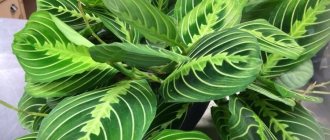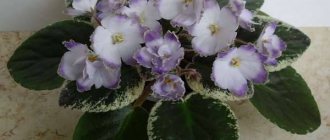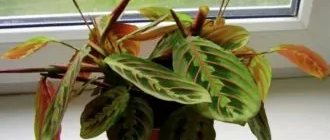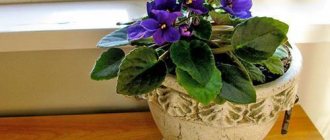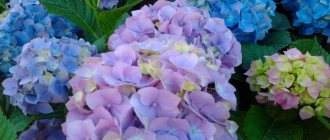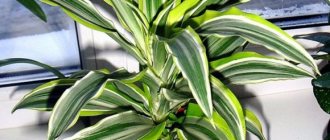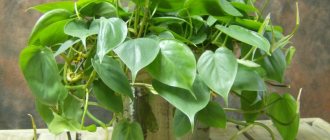Description
Arrowroot is an ornamental herbaceous perennial from the Marantaceae family. It is named after the medieval physician and botanist Bartolomeo Maranta. Sizes and appearance vary greatly depending on the variety. At home you can rarely find arrowroot taller than 30 cm, however, in natural conditions the height of the bush can reach one and a half meters. The leaves are large, patterned, and oval in shape. A young specimen has erect stems, but with age they lean more and more toward the ground.
This is interesting! With the onset of darkness, arrowroot raises its leaves to the sky, exposing their back side. This is very reminiscent of a believer folding his hands in prayer. This is where the plant got its second name - “Prayer Plant”. Arrowroot also has a third name, and, oddly enough, it is also associated with religion. The shape of the leaves resembles the tablets of Moses, and each leaf has 10 spots, just like the number of commandments on the tablets. That’s why some people call arrowroot the “10 Commandments.”
The root system of arrowroot is represented by tubers. The tubers of some arrowroot species are edible and are cultivated in several countries. Starch is also extracted from them for use in medicine.
Reproduction methods
During spring transplantation, arrowroot can be propagated by dividing the bush. You can also use apical cuttings for these purposes. To transplant or plant a flower, you need to buy a substrate designed specifically for arrowroot crops.
The planting container should be wide, but shallow. It is best to choose plastic pots, which retain moisture much longer. There must be drainage holes at the bottom of the container, and there must also be a layer of drainage at the bottom. For this you can use crushed stone, pebbles, broken brick. This is necessary so that the water does not stagnate in the pot for a long time, otherwise the roots may begin to rot.
Varieties of arrowroot
Several dozen different types of indoor plants are grown at home. The most popular types of arrowroot with photos:
Two-color arrowroot
The main difference between this flower is the absence of tubers. The leaf has an oval shape and is dark and light green in color. The edge of a bicolor arrowroot leaf is usually wavy.
Tricolor arrowroot
It is distinguished by red veins on the leaf blade. The color of the leaves also contains green and yellow. The reverse side of the sheet is painted crimson.
Reed arrowroot
This plant has slightly elongated leaves. They are also painted in dark and light green, while the light spots on the sheet may be located asymmetrically.
Feeding and watering
The indoor arrowroot plant is watered only with well-settled water at room temperature. The soil in the pot should always be slightly moist during the summer and spring periods. With the arrival of winter, the soil should dry out between watering procedures. Insufficient humidity can be indicated by leaves that curl into a tube.
As for fertilizers, this indoor flower is fed from April to September. For this purpose, liquid complex mineral fertilizers are used. Feeding is carried out 2 times a month, and you should follow the clear instructions that are attached to the composition. It must be remembered that this crop is very sensitive to an excess of nutrients in the soil.
If in winter the arrowroot remains to grow under normal conditions, you need to fertilize it once a month. In addition, the fertilizer is diluted twice as weakly. But if the plant is in a dormant period, then in winter you should refuse to apply fertilizers.
Types of arrowroot - varieties with photos
There are a huge variety of arrowroot varieties, but several of them are usually grown at home and on the farm. These are mainly decorative varieties. Breeders are constantly developing new and interesting colors. Most of them can be classified into two categories: bicolor and tricolor, according to the number of colors in which the leaf plate is painted.
White veined arrowroot
The compact perennial bush gradually grows to a semi-ampeloid form. This category includes a number of varieties and subspecies with different leaf colors.
But the general outlines remain unchanged: oblong, medullary or wide leaves, approximately 7x10 to 10x15 cm. They grow at an acute angle relative to the petiole. The rhizome of the bush is developed, with oval tubers resembling potatoes. White veins appear on the leaf blade, which is why the variety got its name. The reverse side of the leaf is usually reddish.
Red veined arrowroot or Fascinator
This is a bright representative of tricolors. The main background of the leaf blade is dark green, sometimes brownish. The leaves become lighter towards the edges. A light stripe runs through the center, from which pronounced transverse veins diverge. They are colored red, the saturation of which varies from very pale to deep purple. Another feature is the broken direction of the stems.
Comb arrowroot
A medium-sized bush reaches approximately 40 cm. The succulent creeping rhizome is short, with fusiform thickenings for the accumulation of nutrients and moisture. The leaves are wide or oblong, up to 15 cm. The edges of the plate are slightly wavy.
The peculiarity of the comb arrowroot is its color. A continuous light green ridge appears on the green leaf, from which broad dark strokes radiate. They form a continuous border, and the ridge gradually becomes sharper.
Reed arrowroot
One of the most interesting and unusual species stands out against the general background. The height of the erect stems sometimes exceeds 120 cm. The leaves are elongated, egg-shaped. They become sharper towards the ends. The edge is painted in a dark bluish tint. The rhizome is densely strewn with tubers.
Maranta Kerkhoven
This is the most common and famous variety. The central vein appears on the dark sheet plate. On both sides of it there are symmetrical strokes, which darken and brown as they grow. At the same time, they remain separate and do not merge into one stripe. There are longitudinal veins, although they are practically invisible.
Maranta Maricella
The background of the leaf blade of this variety is dark green. This makes it stand out from the rest. But the veins and stripes are of a light light green color. This coloring is reminiscent of a classic negative.
Maranta Massanja
This is an exquisite variety, which is also called black arrowroot. Outwardly, it is not far from the classic white-veined one. The difference is that the underlying green background is retained around the edge. From the main vein, diverging longitudinal ones protrude sharply, maximally light or even white. Contrast is provided by dark strokes between them.
Maranta Emeral Beauty
It differs from the previous type in the width of the light stripe. It occupies up to half the sheet, and the color transition is gradual, without pronounced boundaries or spots.
Maranta Beauty Kim
This is one of the most variegated varieties with dark green or brownish spots, light green strokes, streaks and white stripes that can occupy up to half the leaf.
"Massange" (Maranta leuconeura Massangeana)
This variety can be classified as black arrowroot because they have a dark color in the middle of the leaf. The pattern on the leaves has a contrasting shade, the edges of the leaves are green, and there are light green stripes of lateral veins on the sides. The flower itself is miniature, 16 centimeters high.
You need to care for this variety carefully, as the variety is quite capricious.
"Marisella" (M. leuconeura Marisela)
The main background is dark green. Where the central vein is located, a jagged pattern is visible, and the side veins are practically invisible.
"Kerchoveana" (M. leuconeura Kerchoveana)
This is a tall and spreading variety. The leaves of the plant have an elongated shape and their length is 13-16 centimeters. The leaf blade has very bright colors. The background is bright green, with dark brown strokes and eyes. The leaves have spots that do not merge into a continuous mass. The bottom of the sheet is painted in blue and red tones. This variety has a height of 26 centimeters. The flowers are small in size, dim and collected in 2-3 pieces, have a pale lilac hue. The veins on the leaves have a non-relief shape and do not stand out in color at all.
"Beauty Kim" (leuconeura Beauty Kim)
The leaves are smooth, heart-shaped or oval-shaped, with sharp edges. The main background is light green with dark greenish spotted patterns. On the surface of the leaf there are strokes, stripes that have light green, pale yellow or white shades. A few leaves may only be half white. The patterns are located along the main and lateral veins of the leaf, but the veins themselves are dim.
"Emerald Beauty" (leuconeura Emerald Beauty)
This variety is similar in color to the previous one. It has variegated shades, but the pattern is blurry, the background itself is not contrasting, and there are no dark green spots. The leaves are shiny.
In addition to these varieties, there are more than 21 varieties. The varieties that were given in the article are distinguished by the bright color of their leaves. The remaining varieties could not take root in artificial conditions.
Types and varieties of arrowroot
Each specimen of arrowroot will grow unique, because its color is affected by watering, lighting and other care features. But the main role in the appearance of the flower is still played by varietal characteristics. In total there are about 25 types of arrowroot and several hundred varieties. Let's consider those that are popular in indoor floriculture.
White veined (Leuconeura)
The species got its name due to the distinctly protruding white veins on the leaves. The reverse side of the sheet is most often red or burgundy. It has a short stem - no more than 15 cm, wide oval leaves (10-15 cm in length and 5-7 cm in width). This species includes a number of different varieties that differ from each other in shape and color.
Massangeana or Black
A miniature variety that does not grow more than 15 cm. It is the most capricious to care for and is not recommended for beginning gardeners. Arrowroot Massanja is popularly called “Black” because of the very dark color of the center of the leaf blade. The edges of the leaves are green, and in the center there is a white stripe along the central vein. The color of the veins varies from light green to white.
Bicolor
Arrowroot Bicolor has oval leaves with wavy edges. The leaf plates are painted in 2 colors - light and dark green. A feature of this species is the absence of tubers. Bicolor arrowroot is rarely grown at home.
Reed (Arundinacea)
The largest type of arrowroot. It has erect stems up to 130-150 cm high. Each stem has 1 ovoid oblong leaf with a pointed tip (up to 25 cm in length, up to 8 cm in width). The leaves are colored bright green. There is a variegated variety, on the leaves of which, in addition to green, there are white stripes. Arrowroot roots have many starch-rich tubers that are used in the culinary and medicinal industries.
This may be interesting: Tamarind (Indian date) - growing at home
Kerchoveana
Kerkhoven's arrowroot is also known as "Bunny's Foot". It has large leaves of light green color with dark, sometimes brown spots on both sides of the central vein. The spots on the leaves are always clearly separated from each other and never merge into a single stripe. The height of the bush reaches 25 cm. The flowers are white or pale purple. It is an unpretentious variety.
Variety Tricolor or Fascinator
Tricolor is the most popular arrowroot variety grown at home. Sometimes in stores it can be found under the names “Fascinator” or “Red-veined”. The leaves of this variety are painted in 3 colors. The light green color smoothly flows into dark green from the edges to the center. Light green spots again run along the central vein. And all this is decorated with expressive crimson veins. The pattern is somewhat reminiscent of a fish spine. Blooms with light lilac flowers.
Marisella
The background color of the leaves is rich green. The veins and stripes are light green. Arrowroot Maricella is similar to Arrowroot Tricolor and differs only in the color of the veins.
Beauty Kim
It has heart-shaped or oval large leaves. Beauty Kim is a variegated variety. The light green leaves have spots and streaks of light green, yellow, white and pink.
Emerald Beauty
Similar to the Massanja variety. The leaves are the same dark, becoming a little lighter towards the edges. There is a white spot along the central vein, which, in turn, is much larger than that of Massange.
Home care
The secret to successfully caring for arrowroot is maintaining the temperature and humidity conditions.
The ideal soil for constant growth is a mix of leaf, humus and coniferous soil mixed with sand and charcoal. But standard fibrous peat will not work. Also avoid the presence of lime. Provide high drainage at the bottom.
Temperature
The plant does not tolerate heat and heat above +28...+30C. Avoid direct sunlight, drafts, and sudden temperature changes. Optimal in winter – up to +20C. In winter, it is undesirable to lower it below +14C. At this time of year it is important to keep the leaves away from the cold window.
Fertilizer
During active growth, use complex fertilizers. Specialized solutions for decorative deciduous varieties are now sold. But don’t overuse it, because it’s equally important not to overfeed the arrowroot.
Watering
It is recommended to repeat abundant watering only as the top layer of the substrate dries. During cold weather, reduce the frequency to avoid rotting of the rhizome. For irrigation, use filtered water, or at least soft, settled water. Arrowroot is sensitive to any foreign impurities.
Humidity
Ideal air humidity is about 70%. It can be compensated for by systematically spraying the leaves. This is especially important in summer and during the heating season. A tray with water will help to increase the humidity locally, but in this case, make sure that the moisture does not get on the roots.
Arrowroot feels most comfortable in partial shade. In direct sunlight and bright lighting it fades. In the apartment, pay attention to the windows that face northwest or east.
Arrowroot propagation
You don't have to go to the store to get new copies. Reproduction of the plant can be done independently.
Propagation of arrowroot by cuttings
This method is the least traumatic for the “praying grass.” If there are long shoots, they can be used as cuttings. Suitable stems are carefully cut with a sharp knife. If there is an internode, cutting is done 2 cm below it. The size of the cutting should be about 10-12 cm.
The stems are dipped in water to begin the root formation process. The liquid should be at room temperature. The container is located away from direct sunlight. After the roots appear, the cuttings are planted in a container filled with soil, watered and covered with plastic wrap. They are kept in such a “greenhouse” until signs of growth of the above-ground part of the plant appear.
Some people prefer to root shoots in wet sand. The room temperature with this method should be 20-25 °C. The process will last about a month.
Reproduction of arrowroot by dividing the bush
This method is used when replanting plants in spring. The plant removed from the dish is divided into 2-3 equal parts, cutting the rhizomes with a sharp instrument. The fragments are placed in individual pots filled with soil and watered with settled water. Before the young leaves appear, it is better to cover the containers with cellophane.
Transplantation and propagation
Arrowroot transplantation should include the following steps:
- You should remove the plant from the old pot, carefully remove any lumps of soil, prepare a new container, pour drainage first, and then add some of the prepared soil on top.
- Clean the flower from old and yellowed leaves. Wipe healthy leaves from dust and debris. If the bush is large, then it can be cut off at the root.
- Move the plant to a new pot, fill it well with the rest of the soil mixture and tamp it lightly. It is important to carefully examine the composition of the soil before replanting. If there is lime in the soil, then such soil cannot be purchased. Lime will negatively affect the development of the flower.
- Now you need to select fertilizer and top dressing for the arrowroot. Fertilizer must be added once every 14 days. In winter, you only need to add it once a month. Nutrient components must be added along with the liquid in a ratio of 1:1. If the plant is dormant, there is no need to fertilize it, and water it 3 times less often.
Arrowroot is propagated by three classical methods:
- 1. When sowing seeds, start growing seedlings immediately with the arrival of spring. Take a wide flowerpot or box, peat-sand substrate and seeds. The first shoots appear in the next 2 weeks. The main thing is to maintain a stable temperature, about +16°...+19°. As soon as several full leaves appear on the seedling, it can be replanted.
- 2. To root cuttings, cut shoots up to 10 cm from the mother plant with several full-fledged healthy leaves. The whole process takes about 4 weeks. Rooting can be done from May to September. As soon as the root is formed, transplant the arrowroot into a peat substrate.
- 3. Mature and healthy shrubs can be propagated by division. Dig up and clean the bush, then carefully cut the rhizome. It is important that each seedling has several healthy leaves and tubers. Before transplanting, treat the cuts with charcoal to disinfect. After this, they can be planted in moist, loose soil.
It is recommended to replant an adult plant annually, in early spring.
Air humidity and temperature
In order for the plant to be as beautiful as in the photo, the arrowroot flower must be kept in a room with an air temperature of 22-25 degrees in the summer. In winter, a period of rest begins, so the air temperature in the room drops to 15 degrees, not lower. You should also pay attention to the fact that sudden changes in temperature and drafts are dangerous for the flower (Miranda does not like this). Indoor air humidity should be quite high, being about 90%. It is for this reason that it is recommended to spray the leaves of the plant with clean water every day. But if there is lime in the water, the leaf blades may become covered with whitish spots. Maranta also prefers to take warm showers periodically. It is recommended to do this once a month.
Pest and disease control
Arrowroot problems are typical for tropical plants. With a lack of moisture or heat, it weakens and withers, but with an excess of water, root rot appears and fungal diseases develop. This can be prevented by maintaining a stable regime and periodically treating the flower with antifungal drugs.
Leaves are sometimes affected by scale insects. They suck out the juice, which causes the plate to change color, damage and sticky drops appear on it. Parasites are removed mechanically using soapy water. After this, spray the leaves with a special preparation.
When the air is too dry, spider mites appear. You can get rid of them with a hot shower, but this must be done quickly and carefully. But in this way you can destroy parasites without chemicals, and this is especially important in an apartment. There are also special acaricides for pests.
Diseases and pests
In most cases, “praying grass” does not cause any trouble for its owner: it is quite resistant to infection by infectious diseases. However, it is better for every gardener to have an idea of possible problems, so that if a misfortune occurs, he can quickly localize it.
| Symptoms | Causes |
| The tips of arrowroot leaves turn brown |
|
| The leaves are falling |
|
| Arrowroot leaves are drying |
|
| Loss of decorative color |
|
| Stems become limp and dry out |
|
| Arrowroot leaves become covered with dark spots |
|
If arrowroot leaves become pale, the reason lies in excess sunlight.
It is necessary to move the plant to a more shaded place. The plates may turn yellow when the soil becomes alkalized. To eliminate the problem, water the substrate with slightly acidified water. Root rotting occurs when too dense heavy soil is used during replanting. Young leaf blades dry out due to uneven watering or parasites settling on the arrowroot. In general, many problems (slowing growth, deformation of above-ground parts, loss of decorativeness) can be caused by insects. Most often, “praying grass” is attacked by mealybugs, scale insects, spider mites, and thrips. If not properly cared for, sciarids settle on the soil surface.
Signs and superstitions about arrowroot
Superstitions and signs are associated with the flower:
- It is believed that it attracts material well-being and also strengthens the family hearth.
- According to legend, flowering is considered a good sign; with its beginning, the financial condition of its owners begins to improve.
- The placement of the plant in the bedroom makes the connection between spouses stronger and improves mutual understanding.
- Possessing positive energy, it has a beneficial effect on all family members. That is why many people strive to have this “prayer grass” in their home.
Dividing the bush
To propagate arrowroot at home by dividing the bush, you need to remove the plant from the container and divide it into no more than 3 approximately equal parts. All species that have tubers must be a separate part. Those that do not have tubers should have several well-developed roots, as well as several leaves. All cuttings should be planted in separate containers, slightly moistened the soil and covered with a plastic bag on top. The air temperature in the room with seedlings should be about 20 degrees. Periodically, the cover must be removed to allow the plant to ventilate. In addition, the seedlings need to be sprayed and watered. When these plants take root, they must be removed completely.
Problems during cultivation
The main problems when growing arrowroot and how to eliminate them:
| Problem | Causes | Solution |
| The tips of the leaves dry out | Dry air, drafts | Spray more often, place the flowerpot in places where there are no drafts |
| Tarnishing of sheet plates | Lighting too bright | Provide the plant with diffused light |
| Lack of growth | Moisture deficiency | Regularly water the flower and spray it |
| Rotting, lethargy of shoots and leaves | Abundant watering at low air temperatures | Adjust the watering schedule, drain the water from the pan, move the flowerpot to a warmer place |
Arrowroot species
When choosing indoor plants, many people prefer decorative deciduous species, as they decorate the interior all year round. Some of the most spectacular indoor plants with beautiful leaves are representatives of the arrowroot family .
The leaves of arrowroot plants are large , often oval or elongated, with an unusual pattern of bright veins, stripes, and spots. Many plants of the arrowroot family have such an unusual pattern on the leaves that they seem artificially created.
The arrowroot family contains about 400 plant species, divided into 30 genera. All arrowroots grow in the tropical zone, in the forests of South America, preferring lowland wetlands along the banks of rivers and lakes.
Similar features of all arrowroot plants are underground rhizomes, short shoots with rosettes of leaves on long petioles. Most plants with painted leaves bloom unremarkably; they are used as decorative foliage; only one species can be classified as beautifully flowering - saffron calathea with bright inflorescences.
Arrowroot plants are often called prayer plants because as light levels change before rain or at night, they raise their leaves as if in prayer. The leaves of arrowroot plants always turn towards the light, following the sun during the day; they are driven by special thickenings at the base of the leaves, like muscles.
Various species are grown at home - arrowroot, calathea, stromanta, ctenantha . These related plants require the same conditions of maintenance and care. It is better to place several pots with different species or varieties nearby; in a group, calathea and arrowroot look incredibly beautiful and feel better.
Most often, arrowroot can be seen on the windowsills of indoor plant lovers. There are two varieties - veined arrowroot with brown velvety spots and tricolor arrowroot with bright red veins; there is a variety with silver veins.
Arrowroot grows compactly, the stems of the plant are not directed upward, but parallel to the ground, so the plant does not exceed 20 cm in height. Arrowroot has underground tubers in which the plant retains a supply of moisture. Arrowroot leaves are oval, up to 15 cm long, their undersides are a solid burgundy color. As a houseplant, arrowroot tolerates dry air and irregular watering better.
The genus Calathea has taller plants, their leaves are larger and more decorative, but calatheas are demanding in terms of care . There are a total of 150 types of kalati, the name is translated from Greek as “basket”, as the leaves are used for weaving baskets.
There are many varieties used in indoor floriculture, they differ in color, leaf size and plant height.
Calathea Makoya with large thin leaves up to 30 cm long with a silver color and a green twig pattern in the center. The reverse side of the leaves is lilac.
Calathea decorated with a yellow border and pink stripes in the center.
Calathea striped has elongated leaves up to 30 cm with a pattern of dark green stripes on a green background. This plant can reach a height of 80 cm.
Calathea is remarkable with long (up to 45 cm) leaves, which have a wavy edge and a pattern of dark green oval spots radiating from the central vein.
Calathea Lubbers has a pattern of asymmetrical yellow stripes extending from the center.
Ctenanta is similar to calathea, and is also demanding in care. The leaf pattern of the ctenanta is slightly asymmetrical. The leaves grow on thin long petioles, their shape is an elongated oval.
Stromantha is also compact, like arrowroot, due to its short, thick petioles. The long, sharp-tipped leaves are brightly colored with stripes of white, pink, cream and green. The petioles of the plant and the lower part of the leaves are bright purple. Stromantha is demanding in terms of living conditions, so it is often grown in a terrarium where there is constantly high humidity and temperature.
When growing plants from the maranotaceae family at home , careful care is required. Under unfavorable conditions, decorative leaves lose their beauty. The maintenance and care requirements for all arrowroot plants are the same; they consist in creating the most similar conditions to the natural habitat of the plants in nature.
Lighting . All arrowroot plants are light-loving, but cannot tolerate hot sunlight. In direct sun, decorative leaves curl and can get burned. It is better to place plants at a distance from sunlit southern windows, but they will feel comfortable on an eastern or northern window. Grow calathea, stromanta, arrowroot in the back of the room under a phyto lamp; these plants love artificial lighting.
Temperature. Plants of the arrowroot family come from the tropics, so they cannot tolerate even a slight cold snap down to +15 degrees, preferring warmth all year round within the range of +18...+25 degrees. These sissies should be protected from drafts; in summer they should not be taken out into the fresh air.
Watering . Plants of this family in nature often choose places in low-lying wetlands, as they love constantly damp soil. When grown at home, arrowroot plants are watered abundantly, keeping the soil in the pot constantly moist. To prevent water from standing in the pot and the soil from turning sour, drainage must be provided, then after abundant watering, excess water flows into the pan. The stems of these plants rarely rot from excess moisture; more often this occurs from low soil temperatures when the pot with the plant is placed on a cold surface.
Water for irrigation should sit for 24 hours, chlorine will evaporate from it, and it will warm to room temperature.
Air humidity is the main indicator of the maintenance of decorative deciduous plants; the beauty and healthy appearance of the leaves depends on it. At low humidity, the tips and edges of the leaves of calathea, arrowroot, and stromanthus dry out. To maintain high air humidity, plants are often sprayed, washed in the shower, trays with wet moss, expanded clay are placed next to the pots, or a wide container of water is placed.
Fertilizer . Decorative deciduous plants like to be fertilized with organic fertilizer, but it should not be applied more than once a month. Between fertilizing with organic matter, it is recommended to fertilize the plants with complete mineral fertilizer.
When transplanting, overgrown bushes with lush leaves are divided into several parts - this is the fastest way to propagate indoor plants.
Transplantation is carried out in the spring . When increasing the volume of the pot, it is recommended to choose a container one size wider, not higher. When planting a houseplant in a pot, be sure to add drainage to the bottom. The soil for arrowroot should be loose and nutritious; for this, leaf soil, humus, peat and sand are mixed in a ratio of 1:1:1:0.5.
Growing
The plant is quite demanding in care and needs to follow a number of recommendations.
Lighting
Maranta prefers partial shade and diffused light.
Direct rays of the sun are contraindicated for her. The plant reacts to changes in lighting by moving its leaves:
- with sufficient lighting they occupy a horizontal position;
- when there is a lack of light, they are positioned vertically, forming a closed rosette.
Temperature
In spring and summer – 20-26 °C, in autumn and winter – from 16 to 20 °C.
Arrowroots love heat very much, but overheating is destructive for them. During the dormant period, which lasts from October to February, the plant is comfortable at 18-20 °C.
The plant is sensitive to sudden changes in temperature and drafts, so in summer it should not be kept outdoors.
Watering and its features
Arrowroots need abundant watering.
In the warm season, the soil should be slightly moist. In autumn and winter, watering is carried out rarely, allowing the soil surface to dry out. Irrigation water should be warm and soft.
It is important to prevent waterlogging of the soil and overcooling of the roots.
Air humidity requirements
Arrowroot needs air with high humidity.
Even in conditions of high air humidity, Maranta must be sprayed regularly, at least 2 times a day. For the same purpose, the plant is placed under the shower. This is also important for hygienic purposes.
Top dressing
Arrowroot needs constant feeding:
- in spring and summer, alternate mineral and organic matter, adding them once every 2 weeks;
- in the autumn-winter period, fertilizing is carried out once a month.
Transfer
The plant is replanted for the first time 3 years from the moment of planting. Subsequently, young forms are replanted annually in the spring. Adults - if there is a need to change the potty, but at least once every 3-4 years.
Recommendations for choosing soil and container
For Maranta, a shallow, wide plastic container with a spacious (about 5 cm) drainage compartment is suitable.
The plant prefers slightly acidic, loose soil composed of leaf soil and peat, taken 2 hours each of sand. Another composition is possible: 1 hour of sand, 1 hour of humus, 2 hours of peat and 4 hours of leaf soil.
To make the soil loose, add sphagnum, crushed charcoal, pine needles or pine bark.
Trimming
To stimulate the appearance of new shoots, it is necessary to promptly remove excessively elongated old shoots. Pruning in the spring allows you to shape the shape of the plant's bush.
When favorable conditions are created, Maranta will delight you with spectacular foliage, decorating any interior.
Reproduction
Arrowroot reproduces well vegetatively.
Dividing the bush
This is a fairly simple and effective method of breeding Arrowroot, which can be conveniently combined with replanting. The resulting parts of the plant are immediately planted in pots and covered with film, placing them in a warm place (from 20 °C). After rooting, the film is removed and the plant is cared for as an adult.
Propagation using apical cuttings
At the end of May and June, the upper part with 2-3 leaves is cut off from new shoots. The cut parts are placed in water and kept in a warm place with humid air until roots appear (5-6 weeks). As soon as the roots appear, the plants are planted in a peat substrate.
Useful properties of arrowroot
And what does the arrowroot flower, the photo of which is in this article, bring into the house? It is believed that this flower combines Mercury and Mars with the Sun. That is why this plant has a very “hot character”. When located indoors, arrowroot creates protection against various colds and other diseases that are caused by hypothermia. In addition, the powerful energy of this culture calms the nervous system, normalizes sleep, and also dissolves blood clots in blood vessels.
The bright Sun is responsible for leadership and creativity. Energetic Mars is responsible for increasing activity. Mercury is for connecting people. That is why arrowroot is able to neutralize negative and aggressive energy in the house, as well as remove a tense environment and eliminate conflict situations and frequent quarrels indoors.
Many believe that this culture improves the ability to communicate, learn and do business. If a person grows this plant at home, then he can easily make the necessary contacts, study complex sciences, and also quickly make a profit from any projects or favorite activities. Thus, arrowroot helps improve your financial situation. In addition, gardeners who grow flowers at home are less grumpy, fussy and more silent.
You should pay attention to the fact that cats love to feast on this plant. However, you should not be afraid of this, since the culture does not pose any danger to these pets, because the flower is non-poisonous.
If the leaves begin to turn yellow and dry out, this indicates that the air in the room is too dry. In this case, you need to put expanded clay or moss in the tray and moisten it first. You should also increase the number of spraying procedures for the flower itself, as well as the space around it. In addition, arrowroot may turn yellow due to waterlogged soil. In such a situation, it is necessary to reduce the frequency of watering.
Arrowroot price
The cost of arrowroot depends on the form in which you buy the plant. So, for example, if you take a small specimen, with a not yet fully developed root system, then the minimum amount is from 150 rubles. More mature plants - from 490 rubles. It happens that many people give the plant away for free.
But if you want to buy arrowroot for further breeding for the purpose of sale or as a gift to someone, then it is better to spend money on the varietal version. And here the price of a flower can start from 2500 rubles per piece.
Description of exotic arrowroot
The flower with the original name “Arrowroot” is the most striking representative of the Maranthaceae family, which includes approximately 400 species of a wide variety of plants belonging to 30 genera.
As a rule, it grows low, not exceeding the twenty-centimeter mark in height. The plant is notable for its unusual foliage, colored in various tones of green with bright veins and spots. The shape of arrowroot leaves is very diverse.
Turning to the photo of this unusual flower, it becomes obvious why people call arrowroot “praying grass.” The origin of this name is directly related to the “behavior” of the plant in unfavorable growing conditions.
In low light, lack of water or changing temperature conditions, its leaves, usually located horizontally, rise and fold. It looks like it is praying.
There are many types of arrowroot, but in the homes of plant growers you can most often find tricolor arrowroot or tricolor arrowroot.
You can buy arrowroot seeds in a specialized flower shop or in nurseries.
You might be interested in:
- Begonia;
- Aglaonema:
- Bromeliad.
Useful properties of arrowroot
Arrowroot is credited with a lot of beneficial properties. In particular, for example, it is believed that if you place a plant at the head of the bed, it will not only help normalize sleep. But it also helps to lift the mood and increase a person’s performance.
It is also recommended to install arrowroot in those offices where many people work. It is believed that the plant helps to harmonize the atmosphere in the room and the team.
There is also a place for arrowroot in dietetics. For example, the rhizomes of the thickened rhizomes of reed-like arrowroot are used to make dietary flour. It's called arrowroot.
Briefly about cultivation
- Flowering: the plant is grown as an ornamental foliage plant.
- Lighting: bright diffused light. Arrowroot can also grow under artificial lighting, which should work at least 16 hours a day.
- Temperature: in spring and summer – within 23-25 ºC, while the substrate temperature should not be lower than 18 ºC. From mid-autumn to late spring – 18-20 ºC.
- Watering: in spring and summer - abundantly, as soon as the top layer of soil in the pot dries, moderate the rest of the time.
- Humidity: high. It is recommended to spray the arrowroot with warm water all year round and keep it on a tray with wet expanded clay.
- Feeding: all year round, twice a month, alternately with organic solutions and mineral fertilizers in half the dosage.
- Rest period: not clearly expressed.
- Replanting: in early spring every two years.
- Substrate: 1 part sand, 3 parts garden soil and 1.5 parts peat.
- Reproduction: by cuttings and dividing the bush.
- Pests: spider mites.
- Diseases: in improper conditions and due to insufficient care, leaves often lose their decorative properties.
Read more about growing arrowroot below.
